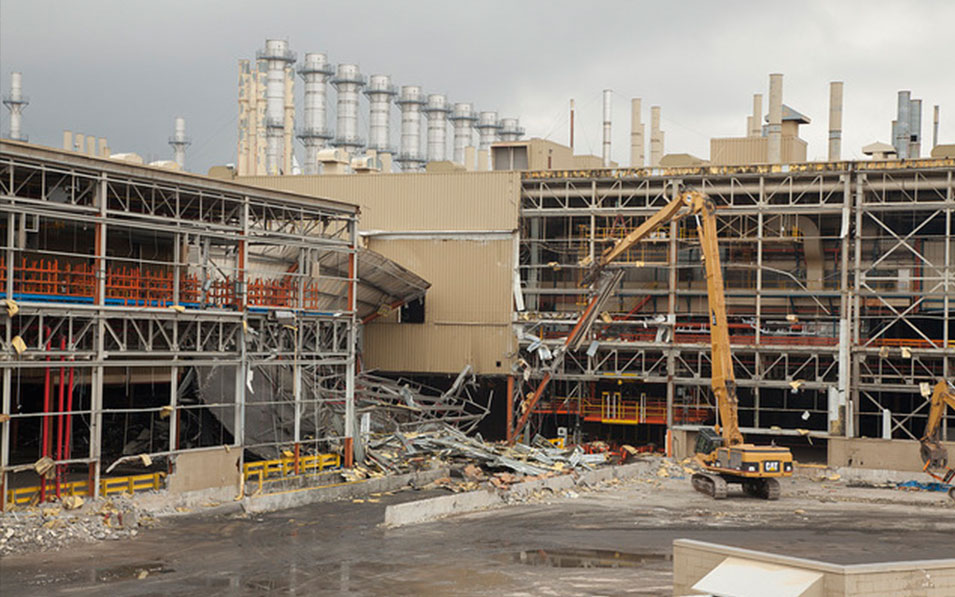
14 Sep General Motors Buick City Demolition
A piece of automotive history is coming to an end. The old General Motors Buick City complex in Flint is being demolished.
They’re demolishing just short of 5 million square feet of an industrial automotive facility. Aside from taking the buildings down, we are processing as much of the material as possible for recycling. There is approximately 100,000 tons of steel and 250,000 tons of concrete and masonry debris. In addition, there is approximately 20,000 tons of landfill material and there is roughly 3,000 tons of nonferrous scrap,said David Mardigian, president of MCM Management Corp. MCM Management Corp. is the prime contractor on the project. The project began in July 2001 and it will be completed in November 2002. Mardigian said that the attachments his company uses are a key element in the successful completion of the project.
“We use attachments that not only allow us to efficiently take a structure as heavy as this down without hand labor, but we also have attachments that allow us to recycle material. The value added with the attachment makes sense, but to add the value to do the same processing of some material with hand labor is inherently unsafe and inefficient, Mardigian said.
We use hydraulic steel shears for demolition and we use hydraulic concrete demolition tools. When the material gets down on the ground, we have a variety of attachments. We have attachments that will reduce the size of the concrete and remove all rebar and we have steel attachments that will cut steel goes straight to the steel mills. Not to a local scrap yard, not to a processor, but to a final destination where it’s melted and used in a new product.
It’ss good environmentally, because our material goes straight to melt rather than local scrap yards that may or may not have old environmental problems. So, we keep our customers from having to become a party to that. It also makes us more competitive on bid day.
“The overwhelming challenge here to out attachments is the size of the structural steel. We have LaBounty’s largest hydraulic mobile shear, the MSD200-III. Until not long ago, it was the largest shear in the world. If has 2,000 tons of cutting force in the throat. It will cut 4-1/2 inches of solid steel. The old way would’ve been to have used torch people to do that. In this case, if we did not have that shear, we wouldn’t have the ability to put enough torch people out there to cut that steel and still maintain a schedule. It just wouldn’t make sense. So, in addition to the productivity aspect, there would be a huge safety factor. When workers are cutting columns that weight 1,200 to 1,300 pounds to the linear foot, there’s a lot of danger involved. A piece could just roll over on their foot and they could lose their foot.
“So the 2,000-ton shear enables us to take this material that historically would go out of here very long and ugly and for just a little bit of money, cut it down into single member pieces less than 5 feet long and go straight to the mill. There is a sister shear working right next to it, a 1,500-ton LaBounty MSD 175-III. These are both series three shears. That means that they are higher speed.†MCM uses Caterpillar equipment on its projects.
We have a tool out here made by Caterpillar, called a MP-40 Multiprocessor, which is on a Cat 375L excavator. The 375 weighs 188,000 pounds and the tool weighs approximately 13,000 pounds. It exerts approximately 1,400 to 1,500 tons of force on a concrete column that is approximately 3 feet in circumference and fully load it with spirally wrapped rerod and turn it to dust in approximately 90 seconds,†Mardigian said.
What that replaces is the old Flintstones routine. If you go to a wrecking job and the first thing you see is a crane and a wrecking ball, all you are seeing is the Flintstones evolved to modern day. It’s indicative of not only no technology, but a very, very old archaic style of demolition.
We have the ability to reach in and cut exactly what we want to cut on a concrete building with the MP-40. The precision with which we can wreck today is orders of magnitude greater than just five years ago. Many of these tools are cutting edge. Many have only been on the market for one or two years. In the case of the Cat MPs, we’ve been able to do a style of demolition that we’ve never done.



Sorry, the comment form is closed at this time.